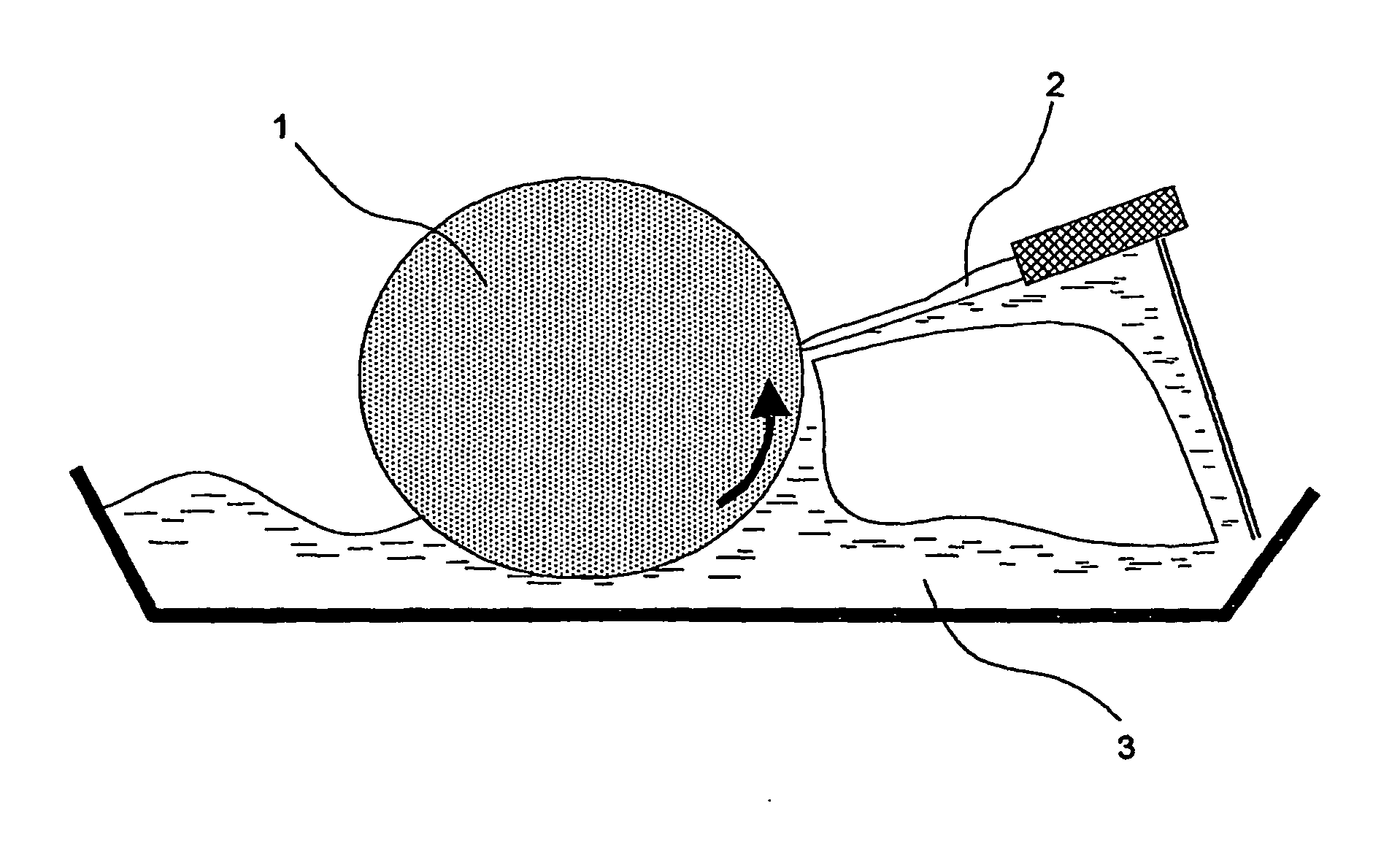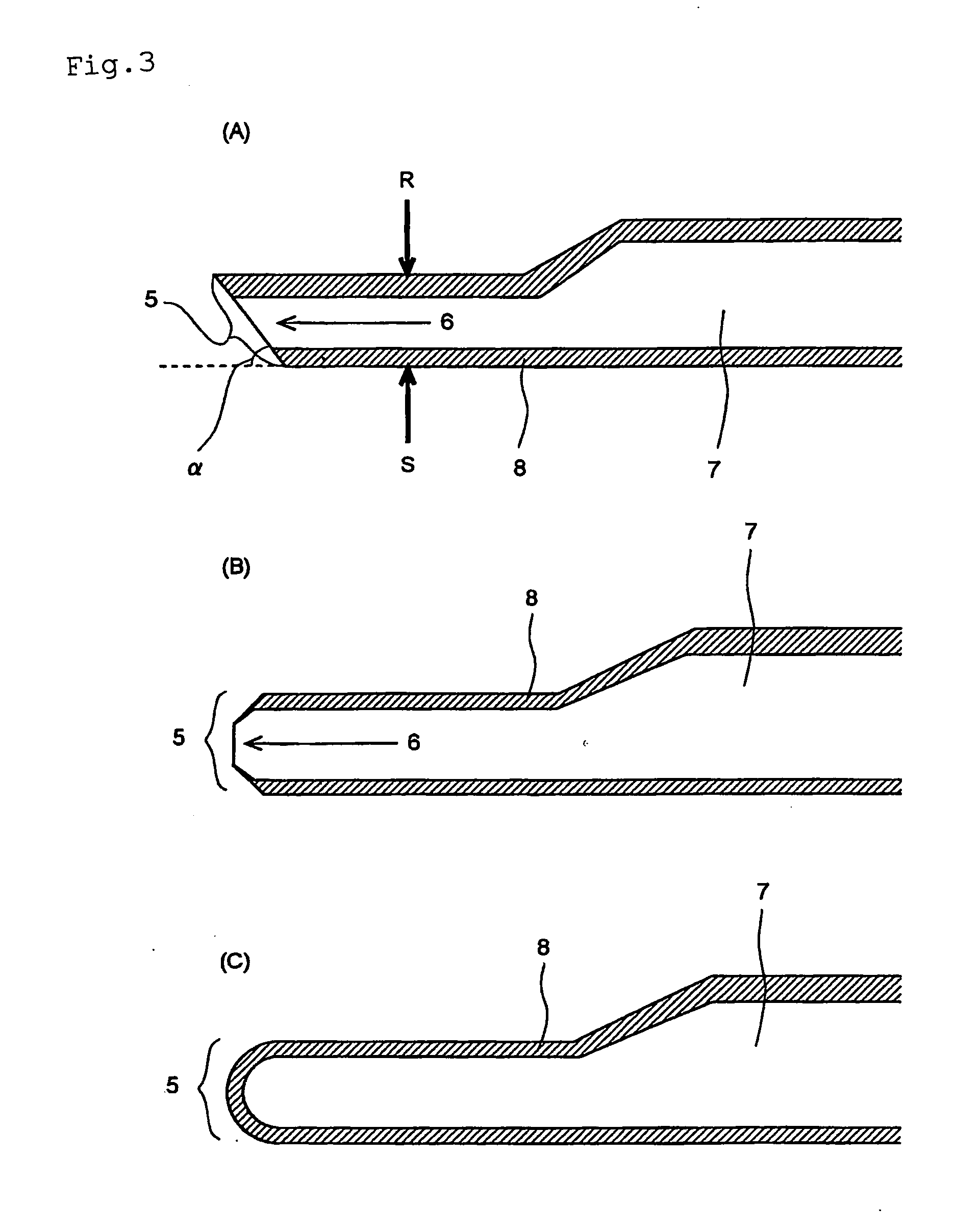Surface treated doctor blade
- Summary
- Abstract
- Description
- Claims
- Application Information
AI Technical Summary
Benefits of technology
Problems solved by technology
Method used
Image
Examples
example 1
Plating Process 1;
[0115] A single-and-parallel-edged steel base material for doctor blade (steel strip having a total length of 50 m) having a plate width of 50 mm, a plate thickness of 0.15 mm, a blade edge width of 1.4 mm, and a blade edge end thickness of 0.07 mm was spirally taken up on a reel together with a spacer consisting of a metal steel strip which had the surface roughened by embossing treatment, and in the state in which it was wound around the reel, it was immersed for 15 minutes in an alkali degreasing solution (Pakuna RT-T (manufactured by Yuken Industry Co., Ltd.), 60 g / L) of 50° C. After being washed in water, it was subjected to a hydrochloric acid activation treatment in a hydrochloric acid activation liquid for 15 minutes, and was then further washed in water. Thereafter, it was immersed in an electroless Ni plating solution in which SiC particles having an average particle size of 0.5 μm were dispersed (plating solution manufactured by Japan Kanigen Co., Ltd....
example 2
Plating Process;
[0134] A single-and-parallel-edged steel base material for doctor blade (steel strip having a total length of 50 m) having a plate width of 50 mm, a plate thickness of 0.15 mm, a blade edge width of 1.4 mm, and a blade edge end thickness of 0.07 mm was spirally taken up on a reel together with a spacer consisting of a rough wire mesh, and in the state in which it was wound around the reel, it was immersed for 15 minutes in an alkali degreasing solution (Pakuna RT-T (manufactured by Yuken Industry Co., Ltd.), 60 g / l) of 50° C. After being washed in water, it was subjected to a hydrochloric acid activation treatment in a hydrochloric acid activation liquid for 15 minutes, and was then further washed in water. Thereafter, it was immersed in an electroless Ni plating solution in which SiC of an average particle size of 0.5 μm were dispersed (plating solution manufactured by Japan Kanigen Co., Ltd.; Sumer SC-80-1: 20 vol %, Sumer SC-80-4; 2 vol %) at 87° C. until a pred...
example 34
Plating Process 1;
[0144] A single-and-parallel-edged steel base material for doctor blade (a steel strip having a total length of 50 m) having a plate width of 50 mm, a plate thickness of 0.15 mm, a blade edge width of 1.4 mm, and a blade edge end thickness of 0.07 mm was continuously subjected to electrolysis (Pakuna Erekuta J (manufactured by Yuken Industry Co., Ltd.): 50 m / l, NaOH: 50 g / l, 30° C., 2.5 A) and washed in water. Thereafter, electric chromium plating (chromic anhydride: 250 g / l, H2SO4: 2.5 g / L, HEEF25C: 20 ml / l, bath temperature: 50° C.) was performed on the specimen, adjusting the plating current and plating time so as to attain a predetermined plating thickness, to thereby prepare a single-layer chromium-plated blade 1.
Surface Adjustment Process;
[0145] Buff polishing was performed on the above-mentioned single-layer chromium-plated blade 1 to completely remove the plating residues or the like from the surface, thereby obtaining a single-layer chromium-plated bl...
PUM
| Property | Measurement | Unit |
|---|---|---|
| Thickness | aaaaa | aaaaa |
| Thickness | aaaaa | aaaaa |
| Particle size | aaaaa | aaaaa |
Abstract
Description
Claims
Application Information
 Login to View More
Login to View More - R&D
- Intellectual Property
- Life Sciences
- Materials
- Tech Scout
- Unparalleled Data Quality
- Higher Quality Content
- 60% Fewer Hallucinations
Browse by: Latest US Patents, China's latest patents, Technical Efficacy Thesaurus, Application Domain, Technology Topic, Popular Technical Reports.
© 2025 PatSnap. All rights reserved.Legal|Privacy policy|Modern Slavery Act Transparency Statement|Sitemap|About US| Contact US: help@patsnap.com



